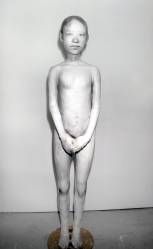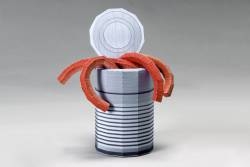Feature: Reviews
Re:con-figure
- Kala Art Institute
- May 1 - June 27, 2009
The inaugural exhibition
in Kala’s expanded new gallery
For thirty years Berkeley’s Kala Art Institute’s exhibition space consisted of a compact area in the back of the printing studio and up several flights of stairs; now, Kala boasts an elegant new gallery with a ground floor entry — just around the corner from their former home. To kick off the exhibition schedule in the new space, they presented re:con-figure, a group show of eleven artists who had been involved with Kala as recipients of fellowships, awards, or residencies.
Re:con-figure addresses issues of verisimilitude: of what is real, and how the constructions presented by the artists on view fit into the nature of reality. We live in a world which is increasingly filled with simulated experiences and objects. We eat artificial food, we read on electronic devices, have conversations on our cells, play in virtual arenas; some practice cybersex — far less messy and no risk of STDs. Films show us worlds that never existed outside of a computer screen.
Strolling through the spacious new gallery, we noted a quality held in common by many of the works: that of hollowness. This gives these works a feeling of lightness, and a sense of being incorporeal, unreal. Our mortality, and a sense of impending violence, informs a number of the works, as well.
Midori Harima presented three sculptural works which were the most evocative in the exhibition, America (coyote) (2008), Untitled (girl) (2009) and Written Word (cobra) (2008). Her process mounts Xeroxed images of animals on papier-mâché constructions, creating thin shells. Monochromatic, mostly white with pale grey accents, and ghostlike, the figures seem vulnerable, fragile; their imploring eyes are haunting.
Randy Hussong’s quirky installation piece confronts two sacred icons: Christianity and baseball. A mesh batting cage houses a life-size statue of the Virgin of Guadalupe, while a single, black baseball is perched on a tee above a hefty pile of empty cubes screen printed with the image of a baseball on all six sides. A mat of astro-turf supports the work, Holy Mother of God That’s a Lot of Baseballs (2008). The number of boxes, 762, corresponds to Barry Bonds’s record-breaking number of home runs. The reference to Christianity might also suggest Bonds’s status as a sacrificial “lamb,” one chosen to take the heat for steroid use. Hussong’s piece is irreverent, a bit cryptic and refreshingly humorous.
Sharing the humorous quality is Packard Jennings, with his video piece, Afghanistan 1985. Snippets of Hollywood movies are juxtaposed to create a new plot, with a subversive intent. Macho stars of yesteryear spout dogmatic platitudes about life, war and keeping the peace. Given the current global conflicts, this is clearly sensitive material, yet Jennings, with a light touch, seems to suggest that it was this very kind of simplistic, good guys vs. bad guys mindset which led us into these untenable situations. Also using aggressive content, Jeff Kao’s Crush on Nature (2009) suspends a cardboard vehicle inspired by the WWII “half-track” tank. Our assumptions about cardboard suggest it is largely benign, lightweight and ordinary. Yet a figure beneath, a huddled form shrouded with fuzzy rugs, appearing to breathe, is threatened. Our lives have perhaps been jeopardized by our aggressive natures, our fondness for large hulking cars — or both.
Scott Kildall and Victoria Scott present wall-mounted digital ink jet prints, paper sculptures and a video. The flat images, precisely articulated shapes in grays, pink, gold, red and a rainbow-hued splash, are clearly designed to be cut out and assembled. The results, objects such as Can of Worms (2008), are playful, in a way, but at the same time insistently literal. Their video No Matter Fly-through(2009) takes us over and around these same objects, like the background of a 3-D shooter game with no one to shoot. Speaking of shooting, we find Bayeté Ross Smith’s wall-mounted installation of a half-dozen photographic portraits. The poster-size Targets (2009) bear pastel-hued “hits” along with splatters and drips. In the center, a pair of small monitors reveals the paintball pistol range event — each subject taking aim at their own image. The guns, of course, are not “real,” the exercise a rather bizarrely loaded symbol.
Leslie Shows and Adriane Colburn give their Exacto knives a workout. Shows’s Comics Study (Emptyness) consists of two long cut paper collages; landscape-based, they transition from dark to light, positive shapes to negative space, playful to ominous. Craggy dark peaks jut up, like the Mountains of Mordor, as intricate, anthropomorphic negative shapes enter from the side; reddish pink hills part, exposing a cavern-like interior where a variety of warm pastel-hued areas house cream-colored figurative negative spaces. Shows’s works once again address the issue of the absence of interior, in two-dimensional form, with negative spaces standing in for figures. Colburn’s visually exciting For the Deep incorporates paper, ink jet printing, wood, paint, Styrofoam, video and sound to explore issues related to mapping the Arctic seas, global warming and attendant political issues. A soundtrack of sea and surf permeates the gallery, competing with the staccato bursts of the paintball gun.
Rounding out the exhibition were Srdjan Loncar’s Value (2008) and a trio of large time-lapse photographic prints of operating rooms by Gary Nakamoto. Loncar installed what appear to be $20,000 stacks of hundreds, actually archival inkjet prints attached to wooden blocks. The profusion of stacks of cash sit next to neatly arranged, gold-hued cases. Nakamoto’s works inhabit a sterile environment — blue paper-covered tables and silver or white equipment with dangling tubes. C Section: Twins, 39 Minutes (2007) and L Urethrosopic Stone Manipulation, 199 Minutes (2008) appear to take place in the hospital, while Orchidectomy, 22 minutes (2009) seems to be at the vet, with a pointy-nosed canine supine on the table; the atmosphere of sterility and impersonality, and the fragility of life under these circumstances, remains.
Kala’s new space is a welcome addition to the increasingly vibrant East Bay gallery scene. Re:con-figure, with a thought-provoking selection of lively and intelligent works, presented a promising beginning, one which portends good things to come.


